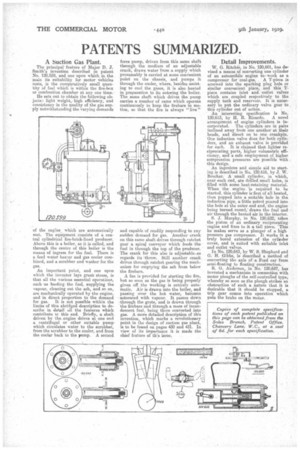PATENTS SUMMARIZED.
Page 22

If you've noticed an error in this article please click here to report it so we can fix it.
A Suction Gas Plant.
The principal feature of Major D. J. Smith's invention described in patent No. 120,50, and one upon which in the main its suitability for motor vehicles rests, is the comparatively small quantity of fuel which is within the fire-box or combustion chamber at any one time: He sets out to obtain the following objects; light weight, • high efficiency, and consistency in the quality of the gas supply notwithstanding the varying demands of the engine which are automatically met. The equipment consists of a central cylindrical fire-brick-lined producer. Above this is a boiler, as it is called, and through the centre of this boiler is the means of ingress for the fuel. There is a feed water heater and gas cooler combined, and a scrubber and washer for the gas. An important point, and one upon which the inventor lays great stress, is that all the various essential operations, such as feeding the fuel, supplying the vapour, cleaning out the ash, and so on, are mechanically operated by the engine, and in direct proportion to the demand for gas. It is not possible within the limits of this abridged description to describe in detail all the features which contribute se this end. Briefly, a shaft driven by the engine drives at one end a centrifugal or other suitable pumpwhich circulates water to the scrubber, from the scrubber to the cooler, and from the cooler back to the pump. A second
force pump, driven from this same shalt through the medium of an adjustable crank, draws water from a supply which presumably is carried at some convenient point on the chassis, and pumps it through the cooler, where, besides assisting to cool the gases, it is also heated no preparation to its entering the bailer. The same shaft which drives the pump carries a number of cams which operate continuously to keep the firebars in motion, so that the fire is always " live"
and capable of readily responding to any sudden demand for gas. Another crank on this same shaft drives through ratchet gear a spire) conveyor which feeds the fuel in through the top of the producer. The crank for this also is adjustable as regards its 'throw. Still another crank drives through ratchet gearing the mechanism for emptying the ash from below the firebars.
A fan is provided for starting the fire, -iut so soon as the gas is being properly given off the working is entirely automatic. Air is drawn into the boiler, and passing over the hot water, be-Comes saturated with vapour. It passes down ,through the grate, and is drawn through the firebars and through a mare of incandescent fuel, being there converted into gas. A more detailed description of tbis invention, which marks a revolutionary point in the design of suction gas plant, is to be found on pages 430 and 431. In view of its importance it is made the chief feature of th's issue,
Detail Improvements.
W. G. Ritchie, in No. 120,601, has devised a means of converting one cylinder of an automobile engine to work as a
compressor for coal-gas. A T-piece is screwed into the sparking plug hole or similar convenient place, and this 1'piece contains inlet and outlet valves which are coupled respectively to the i supply tank and reservoir. It s necessary to put the ordinary valve gear to this cylinder out of action. An interesting spepification is No. 120,613, by H. R. Ricardo. A novel arrangement of engine cylinders is incorporated. The cylinders are in pairs inclined away from one another at their heads, and direct on to one crankpin. One induction valve does for both cylinders, and an exhaust valve is provided for each. It is claimed that lighter reciprocating parts higher volumetric efficiency, and a safe employment of higher compression pressures are possible with this design.
An ingenious and simple aid to starting is described in No. 120,616, by J. W. Brocker. A small cylinder, in which, near each end, are drilled small holes, is filled with some heat-retaining material. When the engine is required to he started. this cylinder is first of all heated, then popped into a suitable hole in the induction pipe, a little petrol poured into the hole at the outer end and, the engine being turned round, draws the fuel and air through the heated air in the interior.
S. J. Murphy, in No. 120,622, takes thepiston of an ordinary reciprocating engine and fixes to it a tail piece. This he makes serve as a plunger of a high pressure gas compressor. It works in a truly bored extension of the cylinder cover, and is suited with suitable 'inlet and outlet valves.
In No. 120.643, by W. S. Shepherd and G. H. Gibbs, is described a method of converting the axle of a Ford car from semi-floating to floating construction.
R. Gs Andersen? in No. 120,687, has invented a mechanism in connection with motor ploughs of the self-controlled type, whereby so soon as the plough strikes an obstruction of such a nature that it is desirable that it should be stopped, trip gear comes into operation which puts the brake on the motor.






















